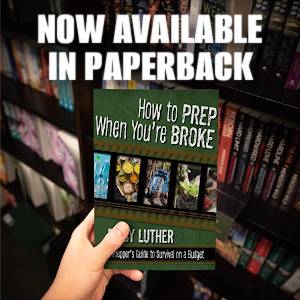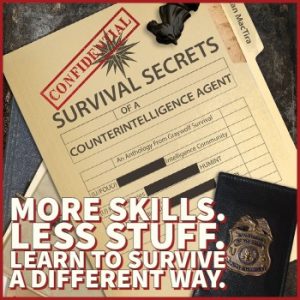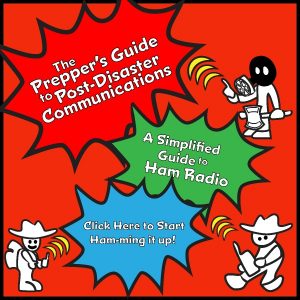If you're new here, you may want to subscribe to my RSS feed. Thanks for visiting!
There’s a reason we call them “worry warts”! No one wants to be that person worrying needlessly. As Thomas Jefferson wisely observed in 1825, “How much pain have cost us the evils that never happened?”
However, during this long and drawn-out slow-boiling SHTF that we find ourselves in, worry is difficult to avoid. What I’m going to share with you today is an evidence-based, quick, and easy practice to INTERRUPT the worry cycle and return yourself to equilibrium and peace. During this marathon of stress, you need your energy for the basics. Worry just drains you.
Even if a full-out SHTF were to erupt, you could modify this technique to use then. Heck, you could even implement it in your core survival group to improve resiliency and mental health! Interested? Let’s start at the beginning, shall we?
What is Worry?
I think we all know that worry isn’t a lot of fun. But what is it, exactly? As licensed clinical social worker Kim Pratt observes, it is important to make a distinction between thinking and worrying. Thinking, she writes, is a “good thing. It involves reflection and analysis that leads to greater clarity and purposeful action, when action is necessary.” However, worrying is not marked by clarity and action. In contrast, worrying “tends to be colored by a negative bias. For example, catastrophizing – imagining the worst – is a hallmark sign of a worrying. Worrying also feels more repetitive and unproductive, in comparison to thinking.”
I like this contrast because it captures my own experience of worrying: I feel caught in a loop of negativity where all of the outcomes are bad. I agree that worrying does not feel productive!
As Diane Solomon, PhD/Nurse Practitioner, observes, it’s easy to get caught in the worry trap, but it can have dangerous consequences for our health: “We’ve all done it, even if we know worry doesn’t help. Worries, by their nature, are often outsized. And the more we worry, the more our brain learns to worry. It’s not that any particular problem is not serious or in need of attention. But anxiety—while a healthy signal of what may deserve our focus—can in excess be harmful to problem-solving and health.”
Now, I’m all about proactive and preventative health. I don’t want to harm my health. However, a recent bout of stress had me worrying about an episode where I had been bullied in my professional work and how I would deal with the bully, whom I still had ties to.
What Doesn’t Work
At some point, we’ve all been told just to pull up our bootstraps and get on with it. When it comes to negative thinking and worrying, this doesn’t work. You can’t just tell yourself not to worry. Why is that? Because the worry becomes more prominent in your thoughts. A famous psychological experiment proved this, when participants were asked to NOT think about a white bear. Guess what? They couldn’t stop themselves. More than that, there was a dramatic effect after the fact, where their thoughts about the white bear rebounded and actually increased at a later time. As mental health educator Melli concludes, “when you try to suppress your thoughts, you actually get more of them than if you didn’t try to suppress them in the first place.”
The Worry Time Technique
Alright! Enough about those worrying thoughts! Here’s what you can do about them.
Set aside a time each day to worry. To start, around 15 minutes would be good. If you are still reading the news, you could actually include another 15 minutes of news reading in your worry time.
Personally, I have stopped consuming all news media, other than our local, independent newspaper, which can be quite informative and heartwarming.
Schedule your worry time for a time and place where you can focus. It should not be scheduled too close to your bedtime, so at least a couple of hours before that.
If, during the day, you have a worrying thought. STOP and tell yourself in a kind way that you don’t need to worry about that right now. You will leave that for your worry time at Xpm. It can be helpful to write down that worry on a list that you save for your worry time.
If you like, you can give yourself a score for how worried you are about that item out of town. Are you 1, totally chill (*then why are you writing it down on your list???) or 10, totally apocalyptic? Then, redirect your thoughts. You can take a mindful deep breath or move along with an activity. Realize that this kind of redirection may take practice or feel awkward at first. In order to see the benefits, you are going to need to try this for at least a week or two.
There are different approaches to how to use your worry time. Some resources recommend that you write out all your worries and possibly work on some solutions. Others recommend that you “Worry away! You can problem solve, write about your worry, paint, draw, doodle, or gaze off into the dust motes. Simply try to focus on your written worries. If you become distracted, gently bring yourself back to your list.” [LINK: ]
At the end of your worry time, if you like the scoring idea, you can rescore the items on your list according to how anxious you feel about them now.
It is important that you not go beyond your planned 15 minutes (for the active worrying.) Add the news reading time on, if you want to. Most sources do not recommend an active worrying time of more than 30 minutes total. Once the worrying time is over, you go back into postponing mode, where you list your worries on your sheet and redirect your thoughts.
You might ask, “What is different about this from thought suppression?” You are not trying to stop the worrying; you have given it a scheduled time. According to mental health experts at the Center for Clinical Interventions, “typically people predict that they won’t be able to postpone their worrying, but often people are surprised that they are actually able to postpone many of their worries, and experience a greater sense of control.” [LINK: ]
This was definitely the benefit I saw! It was a relief to not allow myself to worry, unbridled, all day long. By giving myself that short amount of time to worry, I gave myself relief from thinking about the bully all day long, reduced my stress level, and felt more in control.
What? Me Worry? Heck, Yeah! At 6pm!
Scheduling worry time has been found to reduce stress. Could you see yourself trying the worry time practice offered here? Have you tried this before? How did it work for you? Do you have your own similar practice you can share with us? Please tell us in the comments section.
About Rowan
Rowan O’Malley is a fourth-generation Irish American who loves all things green: plants (especially shamrocks), trees, herbs, and weeds! She challenges herself daily to live her best life and to be as fit, healthy, and prepared as possible.
















4 Responses
What tends to be optimal for scheduled worry time?
morning
afternoon
right after lunch
early evening?
I am not very good with clocks, but if I set 2 pm and all of a sudden, it’s 4, I can do it then, no problem.
Hi LadyLifeGrows,
So sorry for the delay, I tried to post a response earlier today, but it appears to have DISappeared! What I simply wrote is that there wasn’t any findings in the research about when is best, other than a few hours before bedtime is likely preferable. The key, though, is consistency, so think about what time in the day you can consistently schedule your worry time for, and then KEEP it. Give a certain time a try for a couple weeks, and then assess how it went. Wishing you the best. Let us all know how it works for you, if you like.
Thanks Rowan, for such a practical tool.
In my experience:
If worry, anxiety, and depression are a problem. This book gives excellent, commonsense tools to defuse them and feel better.
Feeling Great by Dr. David D. Burns
4.6 score +2,000 reviews
Often, anxiety and depression are due to trauma in the past. Whether you have been traumatized or not, this is an outstanding book to understand it and the people suffering from it.
The Body Keeps the Score: Brain, Mind, and Body in the Healing of Trauma by Dr. Bessel van der Kolk
4.8 score +80,000 reviews.
After a stroke and decades of, not so much worrying, but stressing, I’ve spent the past few years following Matthew 6:34, “Take therefore no thought for the morrow: for the morrow shall take thought for the things of itself. Sufficient unto the day is the evil thereof.” If it isn’t something I have to deal with today, I let it go and “let tomorrow take care of tomorrow.” Whether you are a Christian or not, it’s solid advice. It doesn’t mean you ignore things until the last minute or the deadline is up, it’s just prioritizing and triage. It’s made big difference in my life. I know people who will spend an entire weekend worrying about something at work on Monday (as with many things we worry about they never materialize), when there is nothing they can do about the issue on the weekend.
I also have an ongoing New Years resolution that I call, ” All slates clean”, I forgive anyone who has offended me or did me wrong, forgive doesn’t mean forget, but I let it go. (I have a sister-in-law who jokingly says she waits until December 31st to insult me).